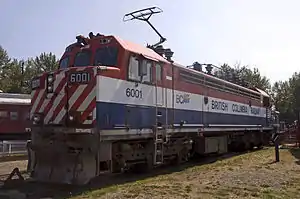GMD GF6C
The GF6C was an electric locomotive for freight duties built by General Motors Diesel in collaboration with ASEA of Sweden.
| EMD GF6C | |||||||||||||||||||||||||
|---|---|---|---|---|---|---|---|---|---|---|---|---|---|---|---|---|---|---|---|---|---|---|---|---|---|
 EMD GF6C locomotive #6001 at the Railway & Forestry Museum in Prince George, BC. | |||||||||||||||||||||||||
| |||||||||||||||||||||||||
| |||||||||||||||||||||||||
| |||||||||||||||||||||||||
| |||||||||||||||||||||||||
Seven of these locomotives were built in 1983 and 1984, for use on the BC Rail's electrified Tumbler Ridge subdivision.
Similar to EMD's GM6C testbed locomotive, the GF6C used a frame and running gear that was identical to that of EMD's popular SD40-2 diesel-electric locomotive,[1] but had a wide cab and carbody similar to that of GMD's SD40-2F.
BC Rail chose electrification for the Tumbler Subdivision because of the long, non-ventilated tunnels, as well as steep grades and sharp curves. The line served the Quintette and Bull-Moose coal mines, and hauled coal from said mines to an interchange with CN, where diesel power took over to haul the coal to Prince Rupert where it was loaded onto deep-sea coal carrier ships.
A combination of the declining coal market, and lack of coal being produced from the Quintette mine led to the electric system being shut down due to low traffic, and high maintenance costs. The system transferred over to diesel hauled trains after the last electrically hauled train left the Teck loadout (Bull-moose mine) on October 1, 2000. Towards the later years of operation, the GF6C units were de-rated due to the high amount of traction motor failures during operation. It is not known what their horsepower rating was after this modification, however loaded trains leaving the east side of the subdivision typically saw the use of 3 leading units, and 3 helper units per train. Previously, each loaded train would typically have 2 leading units, and 2 helper units. The helper units would be cut from the train upon reaching the summit.[2]
In 2004, the Roy family purchased locomotive 6001 and donated it to the Prince George Railway and Forestry Museum in Prince George; the remaining six locomotives were scrapped. 6001 is currently preserved and in remarkable condition, and, according to the museum's curator and park manager, is still operable if provided with 50 kV of electricity.
References
- Marre, Louis A.; Pinkepank, Jerry A. (1989). The Contemporary Diesel Spotter's Guide. Milwaukee, WI: Kalmbach Publishing Co. p. 107. ISBN 0-89024-088-4.
- Sanders, Dale (December 2000). "An Electrified Finale". CTC Board. p. 29.
